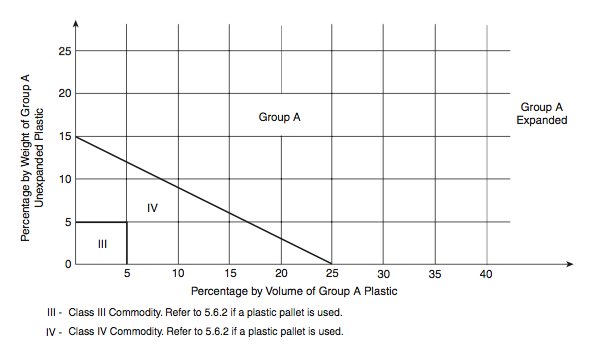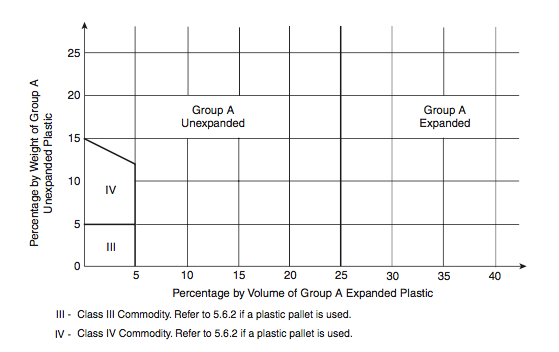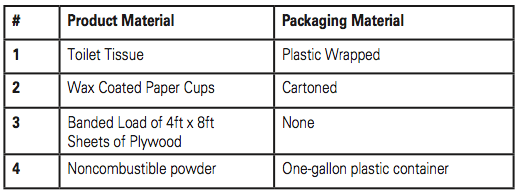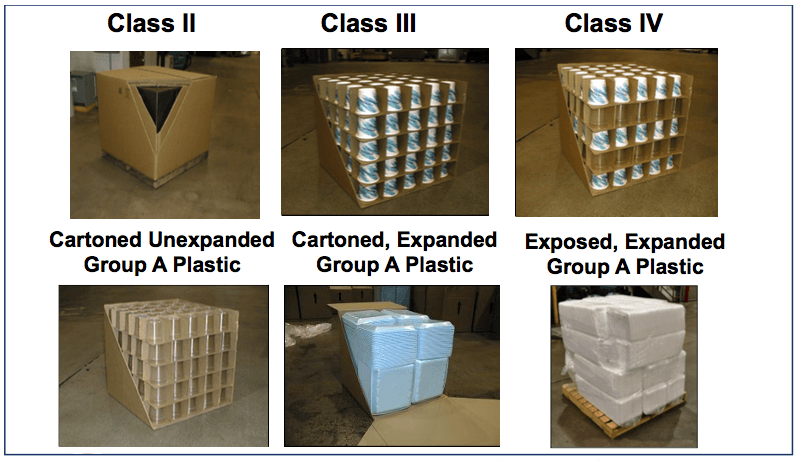It’s Not as Easy as You Think
So you think you can determine the exact commodity classification for a specific packaged arrangement of materials using your knowledge of the commodity classification definitions provided by NFPA 13, Standard for the Installation of Sprinkler Systems? Well, think again. No, you can’t. It’s just not that easy. The heat release rate associated with the burning of a specific arrangement of packaged materials is an extremely complex occurrence involving a multitude of influences, including but not limited to, the materials involved, including the stored materials as well as the packaging; the quantity of each of the materials; the relative position of the materials within the storage array to the advancing flame front; the physical configuration of the materials and available paths for air flow and fire spread within the array; and the list goes on. This doesn’t even consider that the commodity classification is also impacted by the ability, or lack thereof, of the discharging water from the operating sprinklers to affect the heat release rate.
Base Code Mandate
The commodity classification definitions in Chapter 5 of NFPA 13 provide a relatively simple set of criteria to establish the commodity classification, among one of eight different classifications, based on the materials included in the package load along with any pallet used for material handling. These stated definitions provide the following for product stored with or without metal or wooden pallets:
- Class I
A noncombustible product:
- on a wood pallet
- in single layer corrugated carton
- shrink wrapped or paper wrapped
- Class II
A noncombustible product:
- in slatted wood crate
- in solid wood box
- in multi-layer corrugated carton
- Class III
- Wood*
- Paper*
- Natural Fibers*
- Group C Plastics* – See list of Group C Plastics in 5.6.4.3
*May include ≤5 percent Group A or B Plastic (by weight for unexpanded or by volume for expanded). See Figures 5.6.3.3.3(a) and (b).
- Class IV
- Group B Plastic – See list of Group B Plastics in 5.6.4.2
- Free Flowing Group A Plastic
- Cartoned or in a wooden crate that contains >5 percent up to 15 percent Unexpanded Group A Plastic b weight** (See list of Group A Plastics in 5.6.4.1)
- Cartoned or in a wooden crate that contains >5 percent up to 25 percent Expanded Group A Plastic by volume**
- Cartoned or in a wooden crate that contains a mix of Unexpanded and Expanded Group A Plastic within the Class IV region of Figure 5.6.3.3.3(a)**
- Exposed that contains a mix of Unexpanded and Expanded Group A Plastic within the Class IV region of Figure 5.6.3.3.3(b)**
**Remainder being metal, wood, paper, natural or synthetic fibers, Group B or C Plastics. (See Figures 1 and 2)

Group A Plastics – There are four distinct commodity classifications under the designation as a Group A Plastic
- Cartoned Unexpanded Group A
- Cartoned or in a wooden crate that contains >15 percent by weight of Unexpanded Group A Plastic†
- Cartoned on in a wooden crate that contains >25 percent up to 40 percent by volume of Expanded Group A Plastic†
- Cartoned or in a wooden crate that contains a mix of
Unexpanded and Expanded Group A Plastic within the Group A region of Figure 5.6.3.3.3(a) †
- Cartoned Expanded Group A
- Cartoned or in a wooden crate that contains >40 percent by volume Expanded Group A Plastic†
- Exposed Unexpanded Group A
- Exposed that contains >15 percent by weight of Unexpanded Group A Plastic†
- Exposed that contains >5 percent up to 25 percent by volume of Expanded Group A Plastic†
- Exposed that contains a mix of Unexpanded and Expanded Plastic within the Group A Unexpanded region of Figure 5.6.3.3.3(b) †
- Exposed Expanded Group A
- Exposed that contains >25 percent by volume Expanded Group A Plastic†
† Remainder being noncombustible, wood, paper, natural or synthetic fibers or Group A, Group B or Group C Plastics
If the product is stored on a non-listed high-density polyethylene (HDPE) or polypropylene plastic pallets, the commodity classification is bumped up one commodity classification for non-reinforced pallets and two commodity classifications for reinforced pallets, except that no additional increase in commodity classification is required beyond a Group A Plastic designation.

As an aid to further ease the proper identification of the commodity classification, a new Table A.5.6.1.1 has been added to the Annex to provide a roadmap for navigation for these rules. The use of this Table starts by identifying the construction material for the stored product in the first column, then moving to the second column to identify the packaging materials, and along to the third column to include the type of pallet, if any, utilized for support of the load which then lands the user in the fourth column that either identifies the commodity classification or directs the user to the appropriate Figure and/or Section for final determination.

Classifying Commodities
Now that we’re armed with these mandatory provisions of NFPA 13 related to the determination of the proper commodity classification, let’s take a stab at classifying a few commodities. (See Figure 3 above.)
Using the provided definitions for commodities in Chapter 5 and the aid of Table A.5.6.1.1 we can step through each as follows:
- Toilet tissue is a paper product falling within the bounds of the definition of a Class III Commodity. The inclusion of the plastic wrapping material would fall well within the 5 percent weight/volume allowance for a plastic material within the packaged load also within the bounds of a Class III Commodity.
- Paper cups would certainly also fall within the bounds of the definition of a Class III Commodity; however, the definitions do not provide specific guidance as to how to address a wax-coated paper product. For purposes of evaluation let’s assume we would treat it as a Group A Plastic component and again this coating material would surely fall well below the threshold of the 5 percent weight/volume allowance of a plastic material. So, another Class III Commodity.
- Plywood is a wood product again within the exact bounds of a Class III Commodity.
- A noncombustible powder would fall within the bounds of a Class I or Class II Commodity; however, the material is contained in a one-gallon plastic container. The definitions for these two Commodity classifications do not allow for any plastic materials within the packaged load. Assuming that the plastic container material does not exceed the 5 percent weight/volume allowance, the Commodity could then be considered a Class III Commodity.
Wow that was easy – Class III Commodities across the board. But how accurate was our determination? Let’s take a look. Aside from the definitions previously provided and discussed, additional Annex material is provided in the way of Commodity classification examples in Tables A.5.6.3, A.5.6.3.1, A.5.6.3.2, A.5.6.3.3, A.5.6.3.4, and A.5.6.4.1 to aid in the proper Commodity classification. Taking a look at Table A.5.6.3 (the alphabetical listing of Commodity classification examples) for each of the above described examples we find the following:
- Tissue Products; Plastic Wrapped; Uncartoned – Group A Nonexpanded (since it is uncartoned, it would further be designated as Exposed Unexpanded Group A Plastic)
- Cellulosic Paper Products; Wax Coated (e.g., paper plates, cups) Loosely Packed; Cartoned – Group A Nonexpanded (since it is cartoned, it would further be designated as Cartoned Unexpanded Group A Plastic); if the cups are Nested; Cartoned – Class IV Commodity
- Wood Products (e.g., fiberboard, lumber, partible board, plywood, pressboard, with smooth ends and edges); bundled solid blocks – Class II Commodity
- Powders; Noncombustible; Plastic Bottles or Jars up to One-Gallon capacity Cartoned – Class IV

As you can see, the utilization of the mandated provisions of Chapter 5 as a means of determination of Commodity classification is fraught with problems that can end up with incorrect Commodity classifications both to a lesser and worse degree than the commodity examples would indicate.
These examples provided in the 2016 edition of NFPA 13 have been completely reworked and revised to enhance the usability and accuracy of the information provided. A significant number of items have been added and deleted and modified based on the best available commodity classification designations. One of the items that the definitions in Chapter 5 fails to address that the examples do address/include is the position of the various combustible materials within the packaged load, such as plastic materials that are positioned at the face of the packaged load that would represent a direct exposure to fire growth as opposed to being an internal element that would not. Additionally, the configuration of the materials including available fire spread paths and available air flow is considered.
From a user perspective, a simple utilization of the rules prescribed in Chapter 5 would fall significantly short of allowing for a proper determination of commodity classification. As a result, the use of the examples in the Annex is an essential part of the proper determination. In the examples reviewed previously, the determination was fairly straightforward once we found a match in the list of examples in the Annex; however, as the real world would have it, we consistently find ourselves in a position to be asked to classify a commodity that is not included in this list. In those circumstances one must use care and significant judgment for such a determination. In reviewing the list of examples in the Annex, one might utilize a comparative assessment technique to try and find a best fit match for something similar to the specific product at hand. As a further judgment, one might consider a comparative burning rate of the specific product against those of the standard test commodities utilized for each of the eight commodity classifications.
A comparative assessment using applied judgment is essential to the proper determination of Commodity classification for the broad range of products that exist and are encountered in the real world; however, this applied judgment cannot be taken lightly. The proper classification of the commodity is essential to the proper design of the system. A misclassification in commodity will result in an incorrectly designed sprinkler system. As you can see – it’s just not that easy.

Tracey Bellamy, P.E., C.F.P.S., is chief engineering officer for Telgian Corporation, Atlanta, Georgia. He is active in NFPA and represents the company on a number of technical committees including NFPA 13, 30B, and 101. Bellamy is a graduate of the University of South Carolina with undergraduate and master’s degree in civil engineering. He is a registered Fire Protection and Civil Engineer.
 Sprinkler Age A Publication of the American Fire Sprinkler Association
Sprinkler Age A Publication of the American Fire Sprinkler Association
